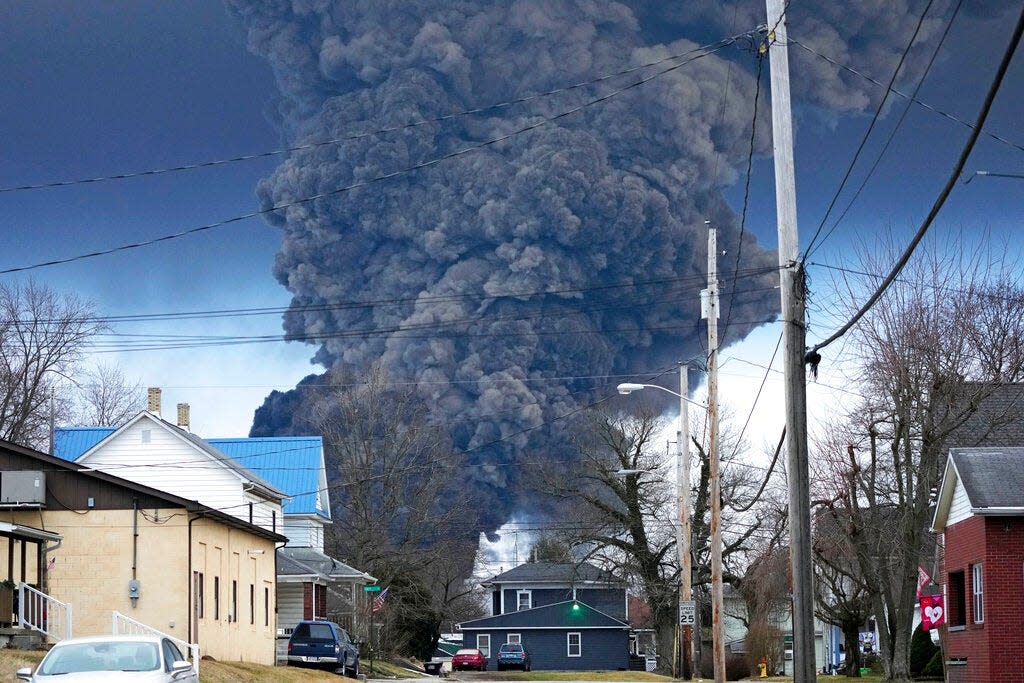Opinion: Now is good time for regulations on fracking

The Norfolk Southern train derailment and detonation of five railcars filled with toxic chemicals killed an estimated 43,000 fish and animals. The incident traumatized Ohio and Pennsylvania communities rightly concerned about immediate and long-term health effects − especially for children and the elderly − and effects on their land, air, water and animals.
Imagine the health impact and outrage if that toxic plume appeared over a large Ohio city.
Now imagine the outrage and health impact when fracking occurs in Ohio state parks − and a large chemical spill, methane leak or groundwater poisoning incident occurs.
There are 4,000 active oil wells and 900 abandoned oil and natural gas wells right now in Ohio. The oil and gas industry needs more strict state and federal oversight and regulation, not less.
H.B. 507, the new law going into effect April 7, requires fracking in state parks and on public lands. It’s a horrible law.
There have been low-level earthquakes in eastern Ohio and other states in the wake of fracking activities since the early 2000s. While oil and gas industry geologists claim toxic chemicals used in fracking fluid are injected deep into the earth, beneath our groundwater − perfectly safe − the more we frack and swiss-cheese the earth beneath us, the more we risk creating tectonic shifts that could release these toxins and allow them to percolate into our groundwater, making parts of Ohio uninhabitable Superfund sites.
Remember that in 2018, one Belmont County, Ohio fracked gas well leaked 120 million metric tons of methane over 20 days − more than countries like Norway and France annually.
Methane leaks and flares occur as a part of oil and gas production. Methane accounts for more than 25% of global carbon emissions, too. Methane is 80 times more potent than carbon dioxide in trapping heat in the atmosphere.
And carbon warms the planet.
News reports say a small number of oil and gas sites with high emissions are responsible for the majority of methane releases. Is Ohio one of those culprits?
We don’t need more natural gas production in Ohio; we need the expansion of affordable, green, sustainable energy. In fact, wind and solar capacity is already slated to overtake natural gas and coal by 2024 due to falling costs and energy security concerns.
Why risk Ohio’s clean air, land and precious drinking water now for more dirty-fuel profits?
Big Oil companies undermine our national interests regarding the war in Ukraine, too. They export oil at a time when domestic demand is down. Additionally, they price-gouged Americans at the gas pump last year and still do today.
Big Oil reported record profits of $200 billion in 2022.
The public needs to know the ingredients and percentage of toxic chemicals in fracking fluid, especially since the average fracked well uses about four million gallons of water. This is similar to the amount of water New York City uses in about six minutes.
Question for state and federal legislators: Were vinyl chloride, benzene and 2-butoxyethanol on the Norfolk Southern train slated to become fracking fluid ingredients?
Right now, by law − or the absence of law − the Ohio oil and gas industry doesn’t have to tell us.
But it should. Now is a good time for the state and federal government to pass laws regulating fracking and requiring disclosure of all ingredients and percentages of ingredients in fracking fluid.
Now is also a good time for the Ohio Oil and Gas Industry to begin its transition to clean energy by capping orphaned and abandoned oil and gas wells, not drilling new ones.
Especially in our pristine and beloved state parks.
Melinda Zemper lives in West Chester.

This article originally appeared on Cincinnati Enquirer: Opinion: Now is good time for regulations on fracking

